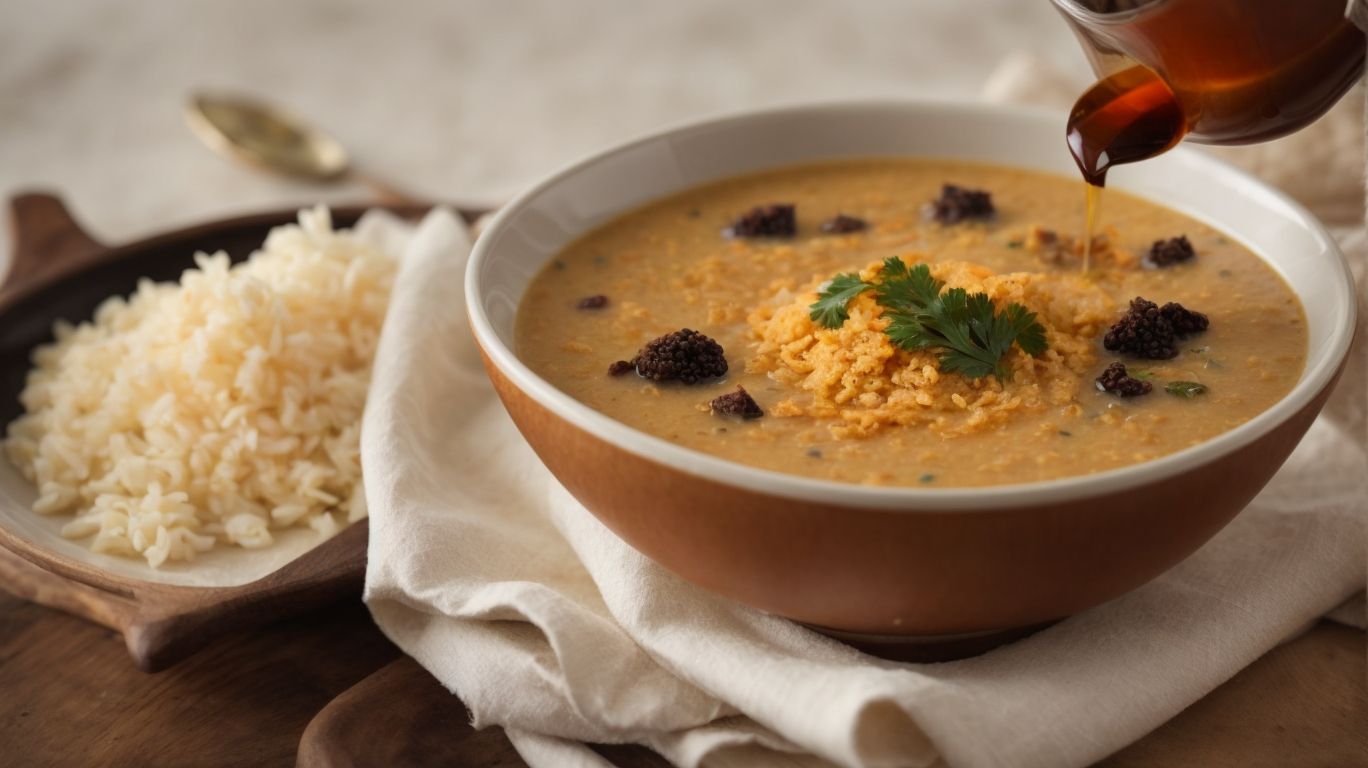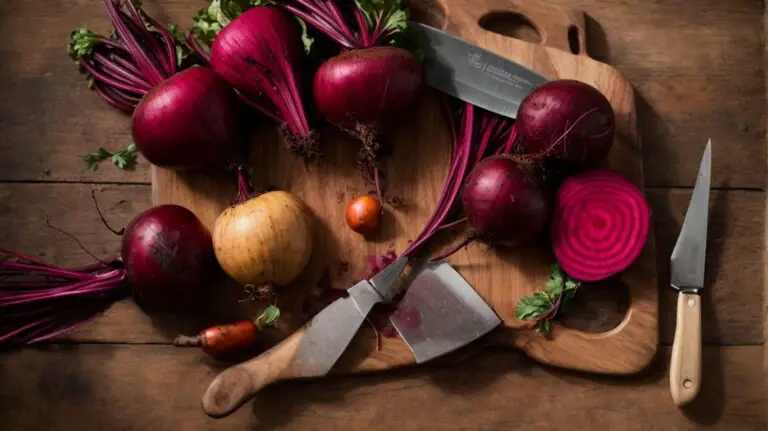How to Cook Egusi Soup Without Vegetable?
Are you a fan of Nigerian cuisine or looking to try something new in the kitchen? If so, you may have come across the delicious and flavorful Egusi Soup.
Have you ever wondered what Egusi Soup is and why some people choose to cook it without vegetables?
We explore the reasons behind preparing Egusi Soup without vegetables, the ingredients needed for this unique dish, the step-by-step preparation process, and what you can serve it with.
Let’s dive into the world of Egusi Soup without vegetables and discover a tasty new recipe to add to your culinary repertoire.
Key Takeaways:
What Is Egusi Soup?
Egusi soup, a traditional Nigerian dish originating from the Ijebu region, is a flavorful soup made primarily with ground Egusi seeds, red palm oil, and an assortment of vegetables and seasonings.
Egusi soup holds a significant place in Nigerian cuisine, not only for its delicious taste but also for its cultural importance. It is often served at special gatherings, celebrations, and family meals, reflecting the country’s rich culinary heritage.
The preparation of Egusi soup involves carefully blending the ground Egusi seeds with other key ingredients like leafy greens, meat, fish, or other protein sources. Variations of this soup can be found throughout Nigeria, showcasing the diverse flavors and cooking styles across different regions.
Why Cook Egusi Soup Without Vegetable?

Credits: Poormet.Com – Roy Adams
There are several reasons one might opt to cook Egusi soup without vegetables, including personal preference, allergic reactions to certain vegetables, and limited availability of specific vegetable ingredients in some regions.
For individuals with personal preference, omitting vegetables in Egusi soup may provide a richer and more concentrated flavor, allowing the nutty taste of the Egusi seeds to shine through in every spoonful. Some people might also choose to exclude vegetables to adhere to a low-carb or keto diet, leveraging the high-fat content of palm oil in the soup for satiety and flavor.
On the other hand, allergic reactions to vegetables like Ugu leaves or bitterleaf can drive individuals to prepare Egusi soup sans any greens to avoid discomfort or health issues. A potential challenge of eliminating vegetables is the reduction in overall nutrient density and fiber content, as the soup may lack the vitamins and minerals usually contributed by the mixed vegetables.
Personal Preference
The decision to cook Egusi soup without vegetables can often stem from personal taste preferences and desired flavor profiles, allowing individuals to tailor the dish to their unique culinary inclinations.
Some individuals prefer a smoother texture in their Egusi soup and find that omitting vegetables helps achieve this consistency. It’s a way to focus on the rich, nutty flavor of the Egusi seeds without the distraction of additional ingredients.
Experimenting with different combinations of spices and seasonings can elevate the overall taste of the soup and make it truly unique to one’s tastes. There are also regional variations in the ingredients used for Egusi soup, with some regions incorporating more seafood or meat for added richness and depth of flavor.
Allergy to Vegetables
For individuals with vegetable allergies or sensitivities, preparing Egusi soup without vegetables can be a suitable alternative to enjoy this traditional Nigerian dish without compromising on taste or culinary experience.
When adapting the recipe, it’s essential to focus on ingredient substitutions that maintain the dish’s rich flavors and textures. Instead of traditional vegetables like spinach or bitterleaf, consider using extra protein options like diced chicken or shrimp. Enhancing the soup with aromatic spices such as cumin, coriander, or paprika can elevate the flavor profile without the need for veggies. Adjusting seasoning levels to balance the new ingredients is key to achieving a delicious outcome.
Limited Availability of Vegetables
In regions where certain vegetables essential for Egusi soup are scarce or seasonally unavailable, preparing the dish without vegetables allows for a creative adaptation that maintains the authentic flavors and essence of this beloved West African cuisine.
When faced with limited vegetable availability, one can explore using alternatives like leafy greens such as spinach, kale, or even pumpkin leaves as a substitute for the traditional bitter leaf. These options not only add nutritional value but also provide a vibrant color and unique taste to the dish.
Incorporating protein sources like fish, shrimp, or tofu can enhance the soup’s texture and make it more filling. Experiment with different spices and seasonings like ginger, garlic, and red pepper flakes to elevate the flavor profile to suit personal preferences.
What Are the Ingredients for Egusi Soup Without Vegetable?

Credits: Poormet.Com – William Rivera
The essential ingredients for preparing Egusi soup without vegetables include Egusi seeds, meat or chicken, red palm oil, and a selection of seasonings and spices to enhance the flavor profile of this classic Nigerian soup.
Starting with the star of the show, Egusi seeds, these melon seeds serve as the base for the soup, providing a nutty and slightly sweet flavor with a rich, creamy texture when cooked. The meat or chicken adds protein and depth to the dish, complementing the earthy tones of the Egusi seeds. Red palm oil not only adds a vibrant color but also a distinct taste that is unique to Nigerian cuisine, while also contributing healthy fats and antioxidants.
- The selection of seasonings, such as Nigerian pepper soup spice blend, crayfish, onions, and garlic, brings layers of aromatic and spicy notes to the soup, elevating its overall taste profile.
- Each ingredient plays a crucial role in creating a balanced and flavorful dish that is not only delicious but also packed with essential nutrients, making Egusi soup without vegetables a satisfying and wholesome meal.
Egusi Seeds
Egusi seeds, also known as ground melon seeds, serve as the foundational ingredient in Egusi soup, providing a rich and creamy texture when blended and cooked to perfection.
These versatile seeds play a crucial role in the consistency of the soup, acting as a natural thickening agent that gives the dish its signature velvety mouthfeel. Egusi seeds are prized for their ability to enhance the overall flavor profile of the soup, adding a nutty and slightly sweet undertone that complements the other ingredients.
Aside from their culinary benefits, Egusi seeds are a powerhouse of nutrients, including essential fatty acids, protein, and minerals like magnesium and phosphorus. This makes Egusi soup not only a delicious delicacy but also a nourishing meal that promotes good health.
Meat or Chicken
In Egusi soup without vegetables, the inclusion of meat or chicken adds a savory and protein-rich element to the dish, enhancing its overall flavor profile and providing a hearty and satisfying meal option.
Whether you opt for tender chunks of beef, succulent pieces of chicken, or flavorful cuts of goat meat, the choice of meat can significantly impact the taste and texture of your Egusi soup. The protein content in the meat not only enhances the nutritional value of the soup but also contributes to a more fulfilling dining experience. The seasonings and spices you incorporate while cooking the meat can infuse the soup with delightful flavors, creating a harmonious blend of tastes.
Palm Oil
The vibrant red palm oil, a staple in West African cuisine, lends both color and depth of flavor to Egusi soup without vegetables, enriching the dish with its distinct aroma and nutritional benefits.
Known for its rich texture and high vitamin E content, palm oil not only enhances the visual appeal of Egusi soup but also adds a unique balance of sweet and savory notes to the dish, making it a favorite among many households. Its ability to withstand high heat makes it a versatile option for sautéing and frying, ideal for those following a keto-friendly diet. The presence of healthy fats in palm oil contributes to a creamy consistency in the soup, blending harmoniously with the Egusi seeds to create a velvety texture that complements the flavors of various spices and seasonings typically used in this traditional West African recipe.
Seasonings and Spices
A blend of aromatic seasonings and spices like onions, habanero pepper, and ground crayfish elevate the flavor profile of Egusi soup without vegetables, infusing the dish with a delightful mix of savory and spicy notes.
Aside from onions and habanero pepper, the addition of stockfish and palm oil further enriches the depth of flavors in Egusi soup. The secret to creating a truly exceptional Egusi lies in the perfect balance of ingredients. Smoked fish adds a distinct umami flavor, while locust beans introduce a unique earthy undertone.
While traditional Egusi recipes often emphasize local ingredients, modern culinary twists have incorporated bell peppers and tomatoes for a tangy sweetness.
Curry powder and thyme bring a touch of warmth, while groundnut paste contributes a rich creaminess that ties all the flavors together. Remember, when it comes to Egusi soup, the art lies in the harmonious dance of seasonings and spices that elevate this beloved West African dish to culinary excellence.
How to Prepare Egusi Soup Without Vegetable?
Preparing Egusi soup without vegetables involves a series of steps that begin with soaking and blending the Egusi seeds, followed by cooking the meat or chicken and incorporating essential seasonings and spices to create a flavorful and satisfying dish.
After blending the Egusi seeds into a smooth paste, you can heat a pot, add palm oil, and fry the Egusi paste until it starts to release its oils, enhancing the flavor profile. Next, add the pre-cooked meat or chicken back into the pot, along with broth or water to create the desired consistency of the soup.
As the soup simmers, remember to stir occasionally to prevent sticking and ensure all the flavors meld together harmoniously. You can adjust the seasoning at this stage, adding salt, pepper, and any additional spices to suit your taste preferences.
Soak and Blend the Egusi Seeds
To kickstart the preparation of Egusi soup without vegetables, begin by soaking and blending the Egusi seeds into a smooth paste, ready to be combined with other ingredients to develop a rich and flavorful base for the dish.
For optimal results, ensure that the Egusi seeds are thoroughly washed before soaking to remove any impurities or debris. Soaking the seeds in lukewarm water for a few hours softens them, making them easier to blend into a velvety consistency.
Regarding blending, using a high-powered blender is recommended to achieve a smooth and creamy texture without any gritty bits. Ensure to add a small amount of water gradually as you blend to facilitate the process and reach the desired thickness.
Cook the Meat or Chicken
Next, cook the selected meat or chicken to perfection, infusing the Egusi soup without vegetables with essential nutrients, proteins, and a robust flavor foundation that complements the rich melon seed base.
When preparing the meat or chicken for Egusi soup, it’s essential to consider the cooking techniques to ensure it reaches the desired tenderness and flavor absorption. Protein content is a crucial aspect to focus on, as meat and chicken are excellent sources of protein that contribute to muscle growth and overall health.
By cooking the meat slowly in the simmering broth, you allow the flavors to meld together, creating a savory base for the Egusi soup. This slow-cooking method not only enhances the taste but also helps in retaining the nutritional benefits of the meat, ensuring that you get maximum health benefits from your meal.
Add the Blended Egusi Seeds and Palm Oil
Incorporate the blended Egusi seeds paste and red palm oil into the cooked meat or chicken, allowing the flavors to meld and develop into a rich and savory Egusi soup base without vegetables, accentuated by the distinctive taste of palm oil.
As the Egusi paste and palm oil mix with the meat, the aromas start to waft through the air, teasing the taste buds with their enticing fragrance. The richness of the palm oil infuses the dish with a deep, earthy flavor, complementing the nutty notes of the Egusi seeds.
During this stage, seasoned adjustments play a crucial role. Adding just the right amount of salt and seasoning enhances the overall taste profile, ensuring a perfect balance of flavors.
It’s fascinating how the umami from the meat intensifies with each passing minute, creating a symphony of flavors that dance harmoniously on the palate. This fusion of ingredients truly showcases the art of taste balancing in cooking.
Season and Simmer
Season the Egusi soup without vegetables with a medley of spices and seasonings, then allow it to simmer gently to marry the flavors and achieve the desired consistency and savory depth that characterize this beloved Nigerian dish.
Once the initial seasoning has been done, it’s crucial to taste the soup and adjust the flavors as needed. Balancing the elements of saltiness, spiciness, and richness is key to achieving a harmonious taste profile. Some cooks prefer to add a touch of umami with a splash of soy sauce or maggi seasoning, while others may opt for a squeeze of fresh lime juice to brighten the overall flavor.
As the Egusi soup simmers, the ingredients mingle, creating a symphony of tastes. The slow, gentle heat allows the flavors to amalgamate, enhancing the overall depth of the dish. It’s essential to periodically stir the soup to prevent any sticking or burning at the bottom, ensuring that every spoonful is infused with the rich essence of the spices and seasonings.
What Can Be Served with Egusi Soup Without Vegetable?
Egusi soup without vegetables pairs excellently with a variety of side dishes, including fufu, pounded yam, rice, Eba, and plantains, offering a diverse culinary experience that complements the rich flavors of the soup.
Traditional Nigerian cuisine often includes classics like Amala or Semovita, which are popular choices to accompany this hearty dish. For a modern twist, some people enjoy serving Egusi soup with quinoa or couscous, adding a different texture and nutritional profile to the meal. Considering the health aspect, incorporating leafy greens or salads alongside can provide a balance of nutrients to the meal, making it more wholesome and fulfilling. This blend of flavors, textures, and nutritional elements creates a satisfying dining experience that celebrates the essence of Nigerian culinary traditions.
Fufu or Pounded Yam
Fufu or pounded yam serves as a classic starch accompaniment to Egusi soup without vegetables, providing a hearty and satisfying base that complements the rich flavors and textures of this traditional Nigerian dish.
Traditionally, fufu is made by pounding starchy vegetables like cassava, plantains, or yams into a smooth, elastic dough-like consistency, while pounded yam involves vigorously pounding yam until it reaches a fluffy and stretchy texture. This process creates a distinct contrast to the Egusi soup, which is a melon seed-based soup cooked with various meats, fish, and spices, offering a savory and nutty flavor that blends harmoniously with the starchy foundation of the fufu or pounded yam.
Rice
Rice can also be a delightful pairing with Egusi soup without vegetables, offering a lighter and versatile alternative that complements the savory flavors of the soup while providing a satisfying and well-rounded meal option.
One of the great things about combining rice with Egusi soup is the textural contrast it brings to the table. While the soup offers a rich and thick consistency, the rice adds a fluffy and light element, creating a harmonious balance that enhances the overall dining experience. The varied seasonings used in preparing both the rice and the soup can contribute to a depth of flavors that dance on your palate.
Eba or Garri
Eba or Garri, traditional Nigerian staples, offer a unique dining experience when paired with Egusi soup without vegetables, providing a satisfying and flavorful combination that resonates with the authentic essence of Nigerian cuisine.
Both Eba and Garri, made from cassava, are staple foods in Nigerian households, cherished for their versatility and comforting texture.
When dipped into the luscious Egusi soup, rich in ground melon seeds and traditional spices, the flavors blend harmoniously, creating a culinary delight.
The marriage of the hearty, starchy Eba or Garri with the velvety, nutty Egusi soup exemplifies the deep-rooted culinary heritage of Nigeria.
This dish not only satisfies the taste buds but also reflects the cultural significance of communal dining and sharing meals with loved ones.
Plantains
Plantains, whether fried, boiled, or roasted, offer a sweet and savory side dish option that complements the robust flavors of Egusi soup without vegetables, adding a touch of freshness and variety to the dining experience.
Plantains are truly a versatile ingredient that can be prepared in various ways to suit different tastes. Whether you prefer them crispy and caramelized from frying, tender from boiling, or slightly charred from roasting, plantains never fail to deliver a burst of flavor. When paired with rich and spicy Egusi soup, they provide a satisfying contrast that elevates the overall dish. You can experiment with seasoning them with spices like garlic, thyme, or paprika to enhance their taste profile further.
Frequently Asked Questions
Can I make egusi soup without using any vegetables?
Yes, you can make egusi soup without using any vegetables. In fact, there are many variations of the soup that do not include vegetables. This is a great option for those who do not enjoy or have access to certain types of vegetables.
What can I use instead of vegetables in my egusi soup?
Instead of vegetables, you can use other ingredients such as meats (chicken, beef, or fish), spices, and herbs to give your egusi soup flavor and texture. Some popular options include shrimp, crayfish, and smoked fish.
How do I make my egusi soup without vegetables taste flavorful?
To make your egusi soup flavorful without using vegetables, you can add a variety of spices and herbs such as garlic, ginger, onions, and bouillon cubes. You can also use meat or fish stock to enhance the flavor of your soup.
What is the best method for cooking egusi soup without vegetables?
The best method for cooking egusi soup without vegetables is to start by sautéing onions and other aromatics in oil. Then, add your preferred protein and spices, followed by the egusi and stock. Let it cook for about 30 minutes, stirring occasionally, until the soup thickens.
Is it possible to make a vegetarian version of egusi soup without using vegetables?
Yes, you can make a vegetarian version of egusi soup without using vegetables. Instead of meat, you can use tofu or other meat substitutes. You can also add more spices and herbs to add flavor to the soup.
Can I freeze egusi soup without vegetables?
Yes, you can freeze egusi soup without vegetables. To freeze, let the soup cool completely and transfer it to an airtight container or freezer bag. It can be stored in the freezer for up to 3 months. When ready to eat, thaw it in the fridge overnight and reheat on the stovetop or in the microwave.







